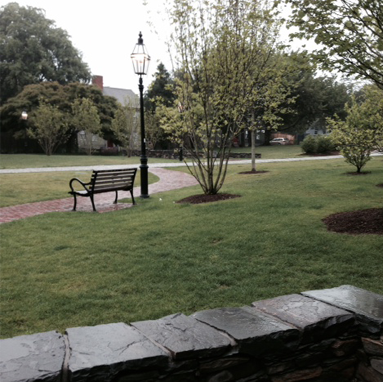A History of Queen Anne Square and the Newport Restoration Foundation
By the early 1970s, the area now known as Queen Anne Square was a downtown urban space filled with a wide variety of buildings which were mostly commercial, and many of which were of little note. Some of these structures were largely abandoned. Within the boundaries of the block lay historic Trinity Church, almost completely hidden by the surrounding commercial development. In essence the area had always been a dense urban place even as early as the mid-18th-century. Its appearance by the 70s was oddly misused, compared with its long history of commercial vitality in the heart of the city.
In 1973, a fire gutted the Walsh Brothers Furniture Store, which anchored much of the Thames Street frontage. The fire left a major hole in the block. A variety of forces within the city started to consider what to do with the area. Newport’s Redevelopment Agency developed a plan to redo the commercial area of Thames Street between Mill and Church Streets. The scheme called for adding some period residential buildings, parking and possibly a small park. Another contingent saw an opportunity to take a different and more aesthetic tack. Mostly at the urging of Trinity Church with support from other quarters, Doris Duke and the Newport Restoration Foundation (NRF) first became interested in the concept of a park surrounded by 18th-century buildings. Between 1974 and completion of the project in 1978, the NRF design staff, strongly influenced by Doris Duke, created the final plans for Queen Anne Square.
Unaccustomed to spending time dealing with bureaucratic red tape, Doris Duke was on the verge of walking away from the project several times until it became clear that she wanted complete control of the project – planning, construction, aesthetic decisions, and, most importantly, financial responsibility. And fortunately, Trinity Church helped with support and negotiations throughout the long process.
In the end, the Redevelopment Agency facilitated negotiating titles to all the property in the area bounded by Mill, Thames, and Church Streets up to the existing church property. Trinity Church also built a new multi-purpose building, the Carr Rice House, designed to blend with the period buildings in the area.
Doris Duke was on site much of the time as the park took shape. Boulders were craned into place, extensive flower beds were planted, and everything was completed to an exacting standard. At two other junctures in the park’s history, Doris Duke took a direct interest in the park and provided equipment and care for its maintenance. By all accounts, she was thrilled by the completion of the park and took great pride in it. Over time, however, Doris Duke grew disillusioned with the lack of maintenance of the original design.
Since the creation of Queen Anne Square, it has been at the center of the city – it celebrates the architectural heritage of Newport and gives residents and visitors alike an open space in which to share an experience of the past. Given Doris Duke’s and the NRF’s role in creating Queen Anne Square – viewed as one of her most important contributions to the community – the Trustees of the NRF and DDMF feel a responsibility to ensure it continues to be one of the community’s key assets, which is accomplished with the new design.

 Formed in 2014 as a 501(c)(3) private foundation, the Queen Anne
Square Maintenance Trust (QASMT) was created to support ongoing maintenance of Queen Anne Square and the public art installation known as "The Meeting Room". The foundation's goal is to ensure the park's longevity and beauty for locals, visitors and future generations.
Formed in 2014 as a 501(c)(3) private foundation, the Queen Anne
Square Maintenance Trust (QASMT) was created to support ongoing maintenance of Queen Anne Square and the public art installation known as "The Meeting Room". The foundation's goal is to ensure the park's longevity and beauty for locals, visitors and future generations.